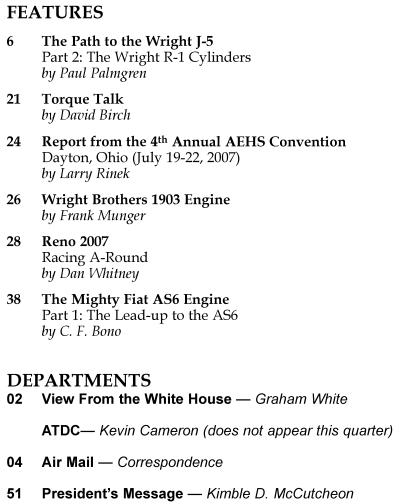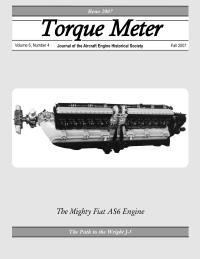
Torque Meter
Fall 2007 Issue
 |
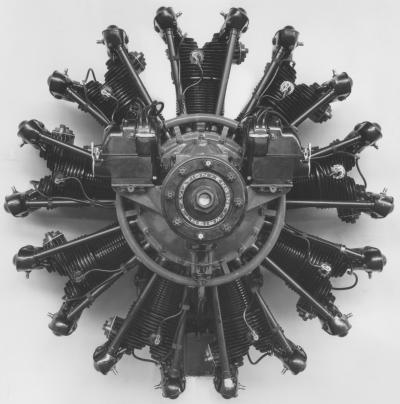 |
The Path to the Wright J-5 Continuing our journey through early air-cooled radial cylinder designs and the significance to the success of the Wright J-5, we find that the Wright R-1 (R-1A, R-2, R-1454) was in development during the same time period as the Lawrance engine. The Lawrance R-1/J-1 was an in-house design, with much Navy encouragement, that was manufactured by various contractors, and then assembled by Lawrance. It was tested and further developed through U.S. Army Air Service and U.S. Navy input. The Wright R-1, which was an Air Service contest award, was heavily developed by the Air Service, with Wright as the initial designer and manufacturer. Although both were of nine cylinder design, the Wright engine was almost twice as large (1,454 in³) in displacement as the Lawrance design (J-1, 788 in³) and somewhat different in execution. One area that does tie these two projects together is the cylinder development and the people involved. Sam Heron, for example, was involved with the Lawrance "K" cylinders, was the designer of at least two of the four Wright R-1 cylinders, and developed the salt-cooled exhaust valve. Although there are differences within these two engines, the later cylinder work was overlapping and assumed shared between them both, especially after Wright purchased Lawrance in 1923. |
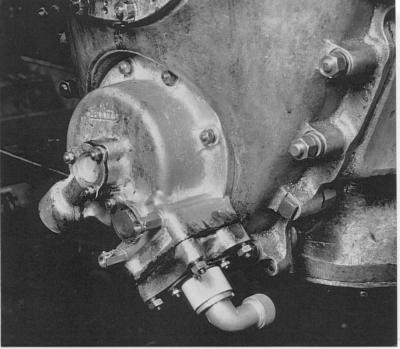 |
Torque Talk This magazine takes its name from a device that measures the power of an engine and is alternatively known as a power-meter. There are a number of ways in which this can be achieved, but this article will explain the hows and whys of Rolls-Royce’s first torque-meter. The requirement for such a device was born of the need for a pilot of a multi-engined bomber to recognise that one of his engines had failed. This may come as a surprise to the reader who might think that such an event would be obvious. Not so, unless there is a catastrophic mechanical failure or a fire. If an engine stopped running on a twin-engined aircraft the effect it produced — yaw — was obvious to the pilot. But with a four-engined aircraft, flying in the blackness of night, with the pilot’s attention occupied by other things, not to mention the noisy environment, a failed engine could easily go unnoticed. Surely, you might say, the pilot’s instruments would tell him. No they wouldn’t. |
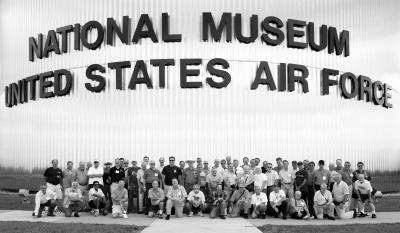 |
Report from the 4th Annual AEHS Convention It was my pleasure to fly from San Francisco, California (with one stop in Minneapolis) to attend the 4th AEHS convention in Dayton. The turnout of aero engine enthusiasts numbered around 75, including two who flew over from Holland. The convention hotel headquarters (Holiday Inn) was on the north side of Dayton right off of I-75, a short distance from the National Museum of the United States Air Force, the star convention attraction this year. I toured this Air Force museum decades ago, and what a difference today: most aircraft are now displayed inside (formerly weathering outside) and new exhibit halls are now in place, including the recent Cold War hangar housing the truly impressive B-36J giant intercontinental bomber (saw this aircraft fly once as a youngster in Connecticut, in May 1956). As a former USAF officer serving on active duty during the Cold War, and an aviation historian, this museum — with its priceless original aircraft and engine collection, is a rather special place (hallowed ground) for me. |
|
Aero Engine Drawings by Frank Munger |
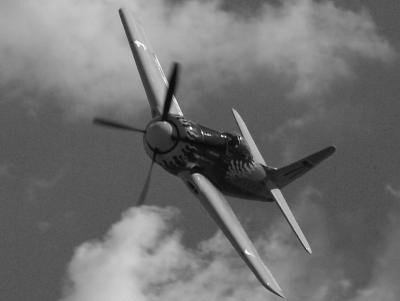 |
Reno 2007 There is nothing to compare to Reno; it can provide the fastest of the fast, and the lowest of the low. We had it all at Reno this year. The first half of the week at Reno is focused on qualifying the airplanes in the various classes. For the Unlimiteds this involves two qualifying sessions a day on Monday and Tuesday, and a single session Wednesday morning, as that afternoon marks the beginning of competition. The six fastest "Unlimited" airplanes are "locked" in to the "Gold" heats, and the rest are distributed by speed into the "Silver" and "Bronze" heats. Winners of a heat race advance to the next class on the next day’s schedule. While some teams try to "psych" out the others by delaying their best effort, there is considerable risk in doing so. The result is that most of the teams attempt to qualify early, hoping that if they do have a problem with the engine or airframe there will be time to get it fixed. Some of the overnight repairs and fixes accomplished are Herculean, to the credit of the hard working crews and committed owners and pilots. |
 |
The Mighty Fiat AS6 Engine, Part 1: The Lead-up to the AS6 by C. F. Bona The object of the present paper is to give an account of Italian high-speed engine designs. By "high-speed" it is meant the speed attained at low altitude by exceptional pilots flying exceptional airplanes where streamlining, weight, wing area and ease of handling have all been sacrificed for the attainment of the single object of high speed. For many years, high speed in aviation has been associated with the name of Jacques Schneider, who, in 1913, initiated the "Schneider Trophy Competition" for seaplanes. In this competition there participated at first standard airplanes with standard engines but later, with interest in the races growing, the aircraft began to be equipped with engines of "forced" design, that is, engines otherwise standard except their power was increased by an increase in the compression ratio. Finally, in recent years, with engine powers rapidly increasing, it was no longer sufficient to increase the engine compression ratio merely but it became necessary to design engines intended exclusively for the races. |
